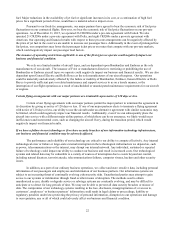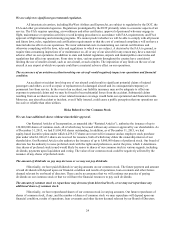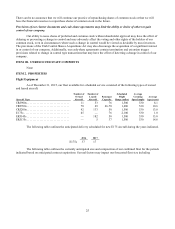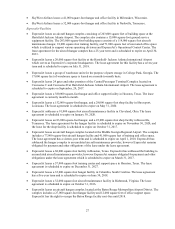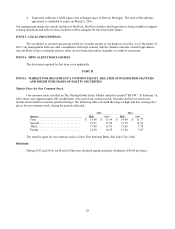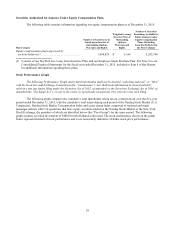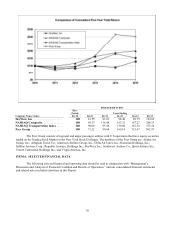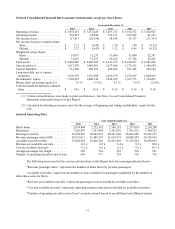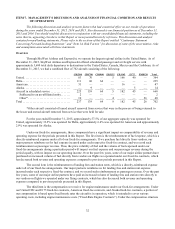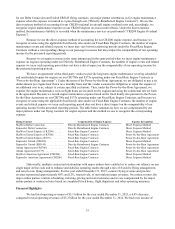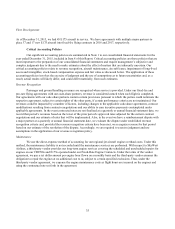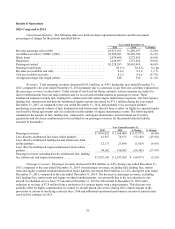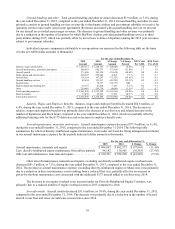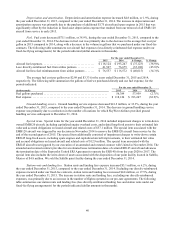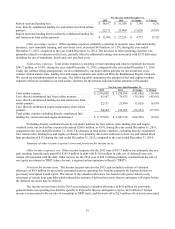SkyWest Airlines 2015 Annual Report Download - page 36
Download and view the complete annual report
Please find page 36 of the 2015 SkyWest Airlines annual report below. You can navigate through the pages in the report by either clicking on the pages listed below, or by using the keyword search tool below to find specific information within the annual report.
32
ITEM 7. MANAGEMENT’S DISCUSSION AND ANALYSIS OF FINANCIAL CONDITION AND RESULTS
OF OPERATIONS
The following discussion and analysis presents factors that had a material effect on our results of operations
during the years ended December 31, 2015, 2014 and 2013. Also discussed is our financial position as of December 31,
2015 and 2014. You should read this discussion in conjunction with our consolidated financial statements, including the
notes thereto, appearing elsewhere in this Report or incorporated herein by reference. This discussion and analysis
contains forward-looking statements. Please refer to the sections of this Report entitled “Cautionary Statement
Concerning Forward-looking Statements” and “Item 1A. Risk Factors” for discussion of some of the uncertainties, risks
and assumptions associated with these statements.
Overview
Through SkyWest Airlines and ExpressJet, we operate the largest regional airline in the United States. As of
December 31, 2015, SkyWest Airlines and ExpressJet offered scheduled passenger and air freight service with
approximately 3,600 total daily departures to destinations in the United States, Canada, Mexico and the Caribbean. As of
December 31, 2015, we had a combined fleet of 702 aircraft consisting of the following:
CRJ200 CRJ700 CRJ900 ERJ135 ERJ145 E175 EMB120 Total
United .................................
83 70 — 5 166 40 — 364
Delta ..................................
111 60 64 — — — — 235
American ..............................
31 — — — 16 — — 47
Alaska .................................
— 9 — — — 5 — 14
Aircraft in scheduled service ..............
225 139 64 5 182 45 — 660
Subleased to an un-affiliated entity .......
2 — — — — — — 2
Other* ..............................
10 — — 4 — — 26 40
Total ..................................
237 139 64 9 182 45 26 702
*Other aircraft consisted of leased aircraft removed from service that were in the process of being returned to
the lessor and owned aircraft removed from service that were held for sale.
For the year ended December 31, 2015, approximately 57.5% of our aggregate capacity was operated for
United, approximately 33.2% was operated for Delta, approximately 6.4% was operated for American and approximately
2.9% was operated for Alaska.
Under our fixed-fee arrangements, three components have a significant impact on comparability of revenue and
operating expense for the periods presented in this Report. The first item is the reimbursement of fuel expense, which is a
directly-reimbursed expense under all of our fixed-fee arrangements. If we purchase fuel directly from vendors, our
major partners reimburse us for fuel expense incurred under each respective fixed-fee contract, and we record such
reimbursement as passenger revenue. Thus, the price volatility of fuel and the volume of fuel expensed under our
fixed-fee arrangements during a particular period will impact our fuel expense and our passenger revenue during the
period equally, with no impact on our operating income. Over the past few years, some of our major airline partners have
purchased an increased volume of fuel directly from vendors on flights we operated under our fixed-fee contracts, which
has decreased both revenue and operating expenses compared to previous periods presented in this Report.
The second item is the reimbursement of landing fees and station rents, which is a directly-reimbursed expense
under all of our fixed-fee arrangements. Our major partners reimburse us for landing fees and station rent expense
incurred under each respective fixed-fee contract, and we record such reimbursement as passenger revenue. Over the past
few years, some of our major airline partners have paid an increased volume of landing fees and station rents directly to
our vendors on flights we operated under our flying contracts, which has also decreased both revenue and operating
expenses compared to previous periods presented in this Report.
The third item is the compensation we receive for engine maintenance under our fixed-fee arrangements. Under
our United CRJ and E175 fixed-fee contracts, American fixed-fee contracts, and Alaska fixed-fee contracts, a portion of
our compensation is based upon fixed hourly rates the aircraft is in operation, which is intended to cover various
operating costs, including engine maintenance costs (“Fixed-Rate Engine Contracts”). Under the compensation structure


